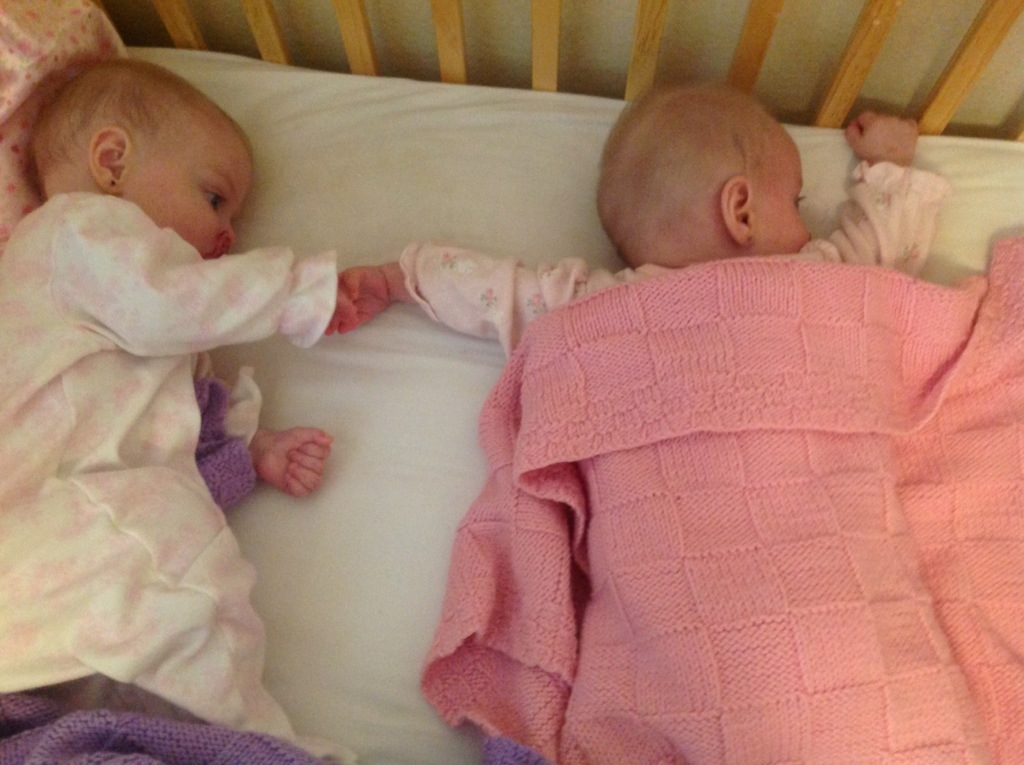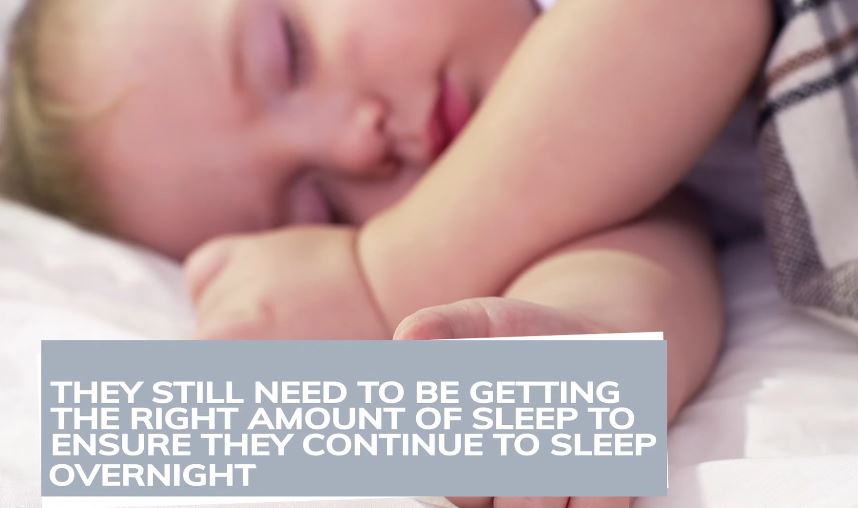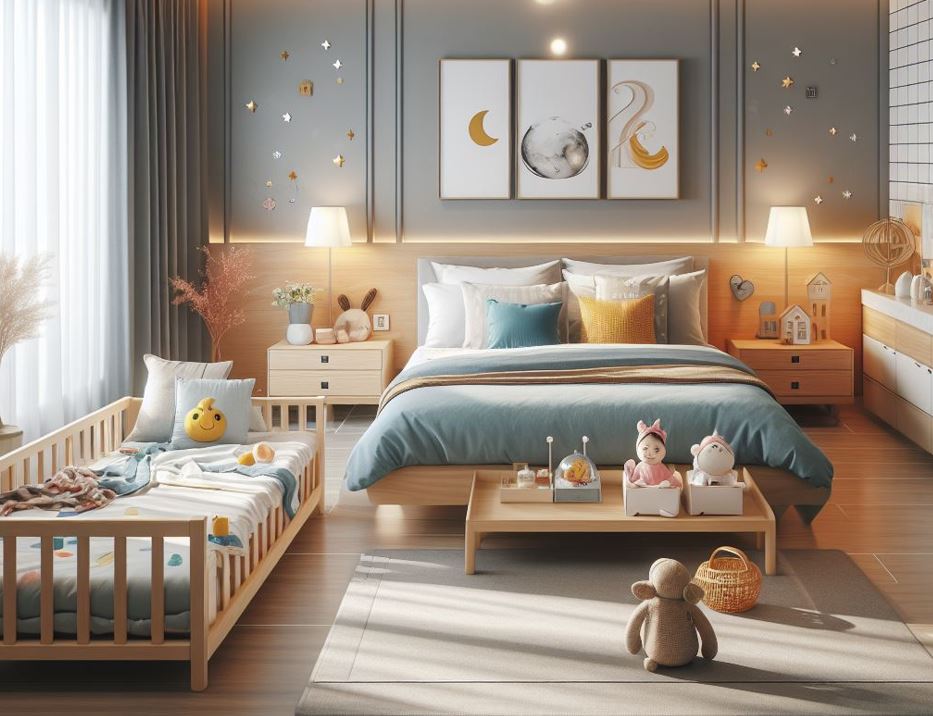Yes, twins can sleep in the same crib. It is generally recommended that both babies should be placed in the same crib at around 3-4 months of age when they start to move more and roll over. When placing twins together it is important to ensure that their heads do not touch each other as this could lead to suffocation and/or injury if one baby rolls onto the other during sleep.
Additionally, pillows and blankets should never be put between them as these items are potential hazards for SIDS (Sudden Infant Death Syndrome). Furthermore, parents should always check on their sleeping twins regularly throughout the night to ensure that they are both safe and comfortable.
Although many parents wonder if it’s safe for twins to sleep in the same crib, research has shown that there is no increased risk of SIDS when twins share a crib. However, there are some practical considerations to keep in mind such as ensuring each twin has enough space and bedding to be comfortable and avoiding over-stuffing the crib with blankets or toys. Additionally, it’s important to remember that even though sleeping together may seem cute, you should never put more than one baby into a single crib at any time.

Credit: twinsandmore.co
Is It Safe for Twins to Share Crib?
When it comes to the safety of your twins, there is no one-size-fits-all answer. Whether or not you decide to allow your twins to share a crib will depend on several factors, such as their individual sleep habits, size and developmental stage. It may be possible for some twins to safely share a crib if both are developmentally ready and they have similar sleeping patterns.
However, in general it’s best practice to provide each twin with his or her own safe sleep space until they reach age 3 due to the risk of suffocation associated with co-sleeping. When deciding whether or not it is safe for your twins to share a crib keep in mind that: 1) They should never be placed head-to head;
2) There needs to be enough room between them so that their bodies are not touching each other; 3) The mattress must fit snugly into the frame without any gaps; 4) Bumpers should never be used in a shared infant bed;
5) Make sure all sheets and blankets are securely tucked around the mattress so there is no risk of entrapment; 6) Do not place stuffed animals, pillows or anything else soft inside the bedding that could increase suffocation risk; 7) Always place babies on their backs when sleeping regardless of how many babies you have sharing a space.
Above all else, prioritize your children’s safety by taking necessary precautions before allowing them both in the same crib.
Do Twins Need 2 Cribs?
When it comes to twins and their need for cribs, the answer is yes. Twins should have two separate cribs so that each baby has his or her own safe sleeping space. Having two separate cribs also allows both babies to be in a comfortable position while they sleep without disturbing one another as well as providing parents with more options when it comes to positioning them safely in the same room.
Additionally, having two separate cribs can prevent one twin from rolling over onto the other – which could lead to injury if not prevented – and provide enough space for both babies’ belongings such as diapers, bottles, toys and blankets. While sharing a bed may seem like an attractive option at first glance, it is far safer for twins of any age to sleep separately in individual beds where there are no risks of entrapment or suffocation due to being too close together. Furthermore, having two different sized beds gives parents the ability to adjust the mattress size according to their infants’ growth rate and changing needs while still maintaining safety precautions recommended by experts.
Can Twins Sleep in a Bassinet Together?
When it comes to having twins, there can be a lot of questions and worries about how to keep them safe. One common question is whether or not it’s okay for twins to sleep in the same bassinet together. The answer is yes!
With proper safety precautions, it can actually be beneficial for both babies if they are placed in the same sleeping area. By sleeping near each other, their presence helps provide comfort and security for one another which can lead to better sleep overall. It’s important that you take into account your own situation when deciding if co-sleeping is right for you, as well as using a bassinet designed specifically for two babies instead of overcrowding one with two infants inside.
Additionally, make sure that all bedding materials are free from loose items such as pillows or blankets that could cause suffocation risk and always place babies on their backs while asleep regardless of whether they’re sharing a space or not. All in all, twin bassinets are an excellent choice when caring for newborns; just remember to practice caution first and foremost!
Do They Make Cribs for Twins?
Yes, they do make cribs for twins! Cribs designed specifically for twins come in a variety of styles and sizes to accommodate two babies at once. The majority of these twin cribs are side-by-side, with each baby having their own space and mattress.
Some feature adjustable rails that can be lowered as the babies grow older or moved further apart if needed. Many parents opt for convertible or modular models which can easily convert from one type of sleeping arrangement to another over time – like converting from a double infant crib into two toddler beds. These types of multi-functional designs provide more bang for your buck since you get more use out of them than just traditional standard twin beds.
Additionally, many companies offer matching furniture pieces such as dressers or changing tables so parents can create coordinated nursery suites perfect for their precious little ones!
Should my twins sleep in the same crib or in separate cribs?
At What Age Should Twins Stop Sleeping Together
At what age should twins stop sleeping together is an often asked question, and the answer varies depending on a variety of factors. Generally speaking, experts suggest that parents begin to transition their twins out of shared sleep arrangements between 6-18 months old. The exact timing depends on how well each twin is able to self soothe and whether or not they are comfortable without the physical presence of their sibling near them.
Ultimately, it’s best for parents to observe both children and decide when they feel it’s time to separate them at night.
Crib Divider for Twins
Crib dividers are a great option for parents of twins who share a crib. They provide an easy and safe way to separate the two babies without having to buy two full-sized cribs. Crib dividers come in many styles, including mesh, fabric, or plastic panels that attach securely to the sides of the crib.
Many models also feature adjustable heights so you can choose exactly how much space you want between your twins’ sleeping spaces.
Twin Cribs Ikea
Ikea offers a great selection of twin cribs for any budget. Their simple and modern designs are perfect for the minimalist nursery, and their range of colors means you can easily find one to match your decor. They also have adjustable mattress heights, so it’s easy to keep up with your growing babies.
Plus, like all Ikea products, they’re built with quality materials that are designed to last.
Newborn Twins Sleeping Arrangements
Newborn twins can be a handful, and figuring out how to arrange their sleeping environment is an important factor in helping them adjust to life outside the womb. When it comes to newborn twins, many parents opt for having both babies sleep in the same crib or bassinet side-by-side. This allows them to still feel close and connected while they are napping, which is comforting for both of them.
Placing two separate bassinets next to each other also works as another option that gives each twin some extra space but still keeps them close enough together so that they can smell and hear one another.
How Long Did Your Twins Share a Crib
Many parents of twins often wonder how long their twins can safely share a crib. The American Academy of Pediatrics recommends that siblings should not sleep in the same bed until they reach the age of one, and ideally, your babies should have separate sleeping spaces at least by 18 months. It is important to give each baby their own space even if it means having two cribs side-by-side or using an innovative option such as a twin bassinet or co-sleeper.
Twins Co Sleeping Death
Co-sleeping with twins can be a dangerous situation, as the risk of accidental death is much greater than for singleton infants. If co-sleeping with twins, parents should make sure to provide their babies with separate sleeping areas that are close enough together so they can still interact but far enough apart to reduce the danger of entrapment and suffocation. Parents should also take extra precautions such as using breathable bedding materials and not allowing either baby to sleep on their stomachs or sides, as this increases the risk of sudden infant death syndrome (SIDS).
First Week With Newborn Twins
Bringing home two new babies is an exciting but overwhelming experience. As a new parent of twins, the first week can be challenging as you adjust to having double the responsibility. Make sure to establish a routine early on by setting regular feeding and napping times for each baby so that everyone in the family knows what to expect every day.
Additionally, don’t forget to take care of yourself during this time – get plenty of rest when you can, ask for help from family and friends if needed, and accept any offers of meals or other assistance. With a little extra support and some patience, your first week with newborn twins will be off to a great start!
Do Twins Sleep Better Than Singletons
Studies have shown that twins generally sleep better than singletons. Twins are usually more comfortable sleeping in close proximity to one another and may even fall asleep with a comforting touch from their twin sibling, allowing them to get better quality rest. Additionally, it has been found that twins often experience fewer night time awakenings as they become accustomed to the presence of their twin during sleep.
Conclusion
In conclusion, there are many opinions on whether twins should sleep in the same crib. Ultimately, it is up to parents to decide what works best for their children and family. While sleeping together may have some advantages such as convenience, maintaining a routine and helping with bonding, safety concerns can be an issue when two babies share a crib.
It’s important that parents weigh all of these factors carefully before making their decision.





Leave a Reply